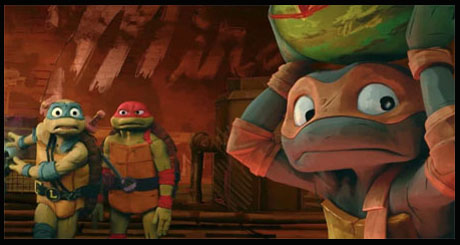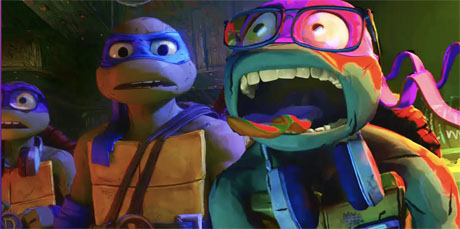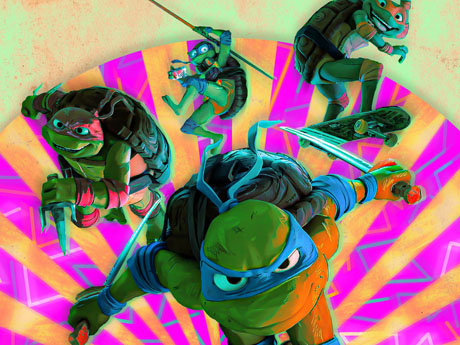
In writing this review, I found limiting the piece to a simple assessment of the movie challenging. Three levels of critique are to be considered; teasing them apart proved adequate to explain only one aspect of Mutant Mayhem in light of the interplay between the factors involved. Therefore, I present my readers with part review, essay, and commentary. While this may seem overblown to some, this animated feature is more complex than it looks, with the unifying theme being evolution.

I.
I begin at the surface level, the animation. I remember attending the premier of Toy Story in 1995. The advent of computer-generated animation in feature-length form was astounding. There was a time when a comparison of Felix the Cat Trifles with Time (1925) with Flowers and Trees (1933) illustrated the gap in animation technology in stark terms; Despite the innovation in the former cartoon, it is evident that animation had evolved exponentially in eight years, and that color would soon become a defining feature of American animation. Toy Story changed the game again in a similar span. I remember sitting with someone during the movie and remarking that every animated film would look very much like it very shortly.
That turned out to be accurate, and traditional cel animation faded as computer-generated animation took over theaters and television productions quickly. The next significant step in evolutionary progression was arguably 2018’s Spider-Man: Into the Spider-Verse, where advancements in CGI technique combined to form a dizzying aesthetic of comic book visual style, impressionism, pop art, and advanced graphic design. Five years later, the sequel was more of a visual restatement of the original, with infinite flexibility added. It was easy to once again say that future animated films would look very much like it very soon.
This leads us to Mutant Mayhem. In a visual sense, it is so close to the aesthetic of the Spider-Verse films that no other comparison exists. Yet, it is another take; Mutant Mayhem displays a scribbly, smeary look that recalls frenetic, shifting fingerpaints layered over sketch work. The Turtles themselves do not echo the original grim-faced Frank Miller-inspired designs that marked their first appearance in 1984; these Turtles recall the characters from the now-iconic 1987-96 television series. Backgrounds and layouts are neither linear, graphic, nor sharp-edged as parts of the Spider-Verse films are. In short, Mutant Mayhem is a variant of modern CGI animation that confirms an evolutionary step in cinema. Expect this new aesthetic to become the norm in feature-length animation.

II.
Mutant Mayhem is also an evolutionary step in other ways. There have been seven TMNT movies before Mutant Mayhem, and it is difficult to call any a quality film. None of them can remotely approach the level of GCI work, scripting, or design, not to mention the protagonists’ characterizations in this reboot. Not one of the preceding films has been less convention-bound than Mutant Mayhem; April O’Neill is now an awkward teen, as much out of place in the human world as the Turtles are, and I believe I only heard the phrase “Cowabunga!” only once. Arch-nemesis Shredder is glimpsed only during a mid-credits scene. For the most part, Splinter is a comic relief figure with only one outstanding action scene. The only significant retention is the omnipresence of pizza, which is merely an adornment.
Mutant Mayhem will also launch a sequel and a new TV series for Nickelodeon, ensuring that the Turtles continue their ascent as a cultural icon. Each time a new movie, series, or line of merchandising appears, a self-perpetuating rise in popularity ensues. The Turtles are now approaching super-iconic status along with Superman, Batman (with whom they once co-starred), Bugs, Mickey, the family Simpson, Spider-Man, and SpongeBob. It is important to note that other once-famous characters that existed at cosmic levels of fame are now fading rapidly for the complex reason that their process of cultural promotion has ceased. Popeye, Betty Boop, and Felix the Cat are examples of this. None of these former superstars have been in the limelight for ages relative to the rapidity of cultural change. No one has rebooted them, and perhaps no one ever will.
The first issue of Teenage Mutant Ninja Turtles appeared as an independent publication in 1984, printed on cheap stock with an estimated print run of some 3200 issues. Creators Kevin Eastman and Peter Laird had a lark creating what they thought would be the ultimate in unlikely superheroes. By linking the Turtles’ origin to that of Marvel’s Daredevil, they even blended in an element of parody. At last reckoning, the fair market value of a highly graded issue of that comic book sits somewhere between $40-60,000. As the Turtles ascend as superstars, it will probably reach $100,000 in the next decade and then be out of reach for all except the wealthiest collectors shortly after that. This is only a bell cow to indicate the actual entertainment value of the Turtles and what they will likely come to mean to the culture that worships them. With Mutant Mayhem, we are seeing the enhancement of cultural capital occur in real-time.

III.
Finally, the movie itself. By bringing the Turtles into true teenhood, Writers Seth Rogen and Evan Goldberg present the most authentic and sympathetic look at teenagers since the apex of John Hughes’ films. In an interview, Rogen stressed that the Turtles’ most salient aspect (underplayed in previous films) was that they were male teenagers. The mutants were unlike many other horny, partying, antisocial deviants seen in other movies. They neither cuss nor do much of anything illegal or vicious; they are the type who would carry an elderly lady’s groceries upstairs. They yearn only to expand their sheltered experiences. They wish to attend school and find girlfriends.
Jeff Rowe, who previously co-directed The Mitchells and the Machines (2021) with Mike Rianda, was perhaps the best choice for Mutant Madness. There are some stylistic similarities between the two films. Rowe also contributed to the writing and screenplay, But Rogen and Goldberg seem to strongly influence the final script. The outstanding animation was provided by a team-up between Mikros Animation, based in France and Canada, and Cinesite, also a Canadian outfit. This is especially notable since neither studio had ever animated a significant feature. Rowe had extensive input into the artistic and character design, working and giving input on much of the visual style. The rap/hip score was composed by Trent Reznor and Atticus Ross and is a perfect fit for the sketchy designs and outrageous characters.
The Turtles face two antagonists. One is Cynthia Utrom, the sinister head of Techno Cosmic Research Institute, seeking the mutagen that accidentally created the Turtles for her nefarious purposes. The other is Superfly, a mutated housefly whose ultimate goal is to turn the planets’ animals into super mutants who will supplant humanity. Encouraged by unpopular high-school girl April’ O Neil, who insists that becoming heroes will gain the Turtles acceptance, the brothers take on TCRI and, later, Superfly in an all-out battle to the end. It won’t be easy; Superfly has the aid of seven powerful mutant animals. Also joining the fray is Splinter, the mutant rat who raised and trained the Turtles in martial arts. No spoilers here, but suffice it to say that a sequel is coming…
No one in the cast disappoints, but the most prominent stars are the teenagers cast as the Turtles. Shamon Brown Jr is Michaelangelo, the most emotive of the four. Leonardo, the de facto leader, is voiced by Nicolas Cantu. Michelangelo, the brains of the quartet, is played by Michah Abbey. Finally, Brady Noon shines as the unpredictable Raphael.
The brothers are among the most convincing teens ever put on the screen, bantering, whining, and pimping on each other like real siblings would, all the while tossing out pop-culture references that do not sound in the least as if they were penned or flung in by an adult. The Turtles are loveable and easy to root for, naïve enough to be taken in by the slippery Superfly but moral and brave when foiling his plans. The scene is heartwarming and genuine when the redeemed and celebrated Turtles finally attend school.
To summarize, Mutant Mayhem is an essential milestone in cultural and animation history and a successful reboot of a beloved series. One can say the same about the Spider-Verse movies. Still, it should be noted that Spider-Man had a twenty-two-year jump on the Turtles, complete with his own animated series, live-action movies, and (lamentable) reboots in his Marvel Comics. If he were to use his Spider-Sense, he would see the Teenage Mutant Ninja Turtles racing behind him in popularity. Cowabunga!
- ANIME REVIEW: “Lonely Castle in the Mirror” - September 24, 2023
- REVIEW: “Teenage Mutant Ninja Turtles: Mutant Mayhem - August 15, 2023
- REVIEW: “Spider-Man: Across The Spider-Verse” - June 7, 2023


 August 15th, 2023
August 15th, 2023  Martin Goodman
Martin Goodman  Posted in
Posted in  Tags:
Tags: 






